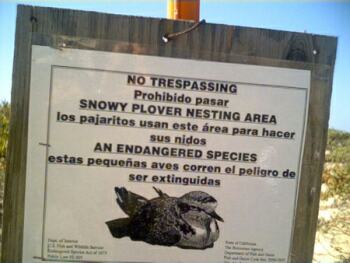
Publisher:
Bonnie King
CONTACT:
Newsroom@Salem-news.com
Advertising:
Adsales@Salem-news.com

~Truth~
~Justice~
~Peace~
TJP
Mar-14-2007 12:40

 TweetFollow @OregonNews
TweetFollow @OregonNews
Western Snowy Plover Nesting Season Begins Along Southern Oregon Coast
Salem-News.comApproximately 18 miles of beach in Oregon are affected by plover recovery efforts.
 A familiar message for Oregon and California beachcombers Photo courtesy: esrm.csuci.edu |
(FLORENCE, Ore.) - The nesting season for the western snowy plover begins on southern Oregon coast beaches Thursday.
During this time some beaches have access restrictions in place to help protect nests and birds with young.
After March 15th, ropes and posts will be used to protect snowy plover nests, eggs and chicks, and restrict access to dry sand portions of certain beaches.
In these areas, only the wet sand portion of the beach will be accessible to beachgoers.
Dry-sand protection efforts will be in effect for habitat sites at Sutton Beach, Siltcoos Estuary, Oregon Dunes Overlook, Tahkenitch Estuary, Tenmile Estuary (northern Coos County), the North Spit of Coos Bay; Bandon Beach State Natural Area and New River area beaches.
The number of plover young that hatch and survive continues to improve each year, thanks in part to the public’s willingness to comply with the beach restrictions.
The public can continue to help by staying back from roped areas and leashing dogs while on the beach this nesting season.
“Visitors doing their part to avoid plover areas and keeping their dogs on a leash while they are near plover habitat has been very helpful. These small measures greatly improve a snowy plover’s chance of surviving,” said Siuslaw National Forest Biologist Cindy Burns.
The Pacific coast population of the western snowy plover was listed by the United States Fish and Wildlife Service as threatened in 1993.
The primary threats to the snowy plover are habitat degradation caused by human disturbance, urban development, introduced European beachgrass, and predators such as crows, ravens, foxes and skunks.
The nesting season ends September 15th.
More information about sensitive plover habitat and targeted beach restrictions can be obtained from the Forest Service, (541) 902-8526, or the BLM, (541) 756-0100.
Articles for March 13, 2007 | Articles for March 14, 2007 | Articles for March 15, 2007


Quick Links
DINING
Willamette UniversityGoudy Commons Cafe
Dine on the Queen
Willamette Queen Sternwheeler
MUST SEE SALEM
Oregon Capitol ToursCapitol History Gateway
Willamette River Ride
Willamette Queen Sternwheeler
Historic Home Tours:
Deepwood Museum
The Bush House
Gaiety Hollow Garden
AUCTIONS - APPRAISALS
Auction Masters & AppraisalsCONSTRUCTION SERVICES
Roofing and ContractingSheridan, Ore.
ONLINE SHOPPING
Special Occasion DressesAdvertise with Salem-News
Contact:AdSales@Salem-News.com


googlec507860f6901db00.html
Terms of Service | Privacy Policy
All comments and messages are approved by people and self promotional links or unacceptable comments are denied.
[Return to Top]
©2025 Salem-News.com. All opinions expressed in this article are those of the author and do not necessarily reflect those of Salem-News.com.